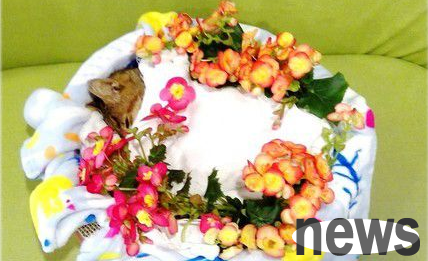Epitaph for dogs | This epitaph for pets has become the “king of monuments”!
Jiaoshan Forest of Steles
"The Inscription of the Crane" is collected in a pavilion on the north side of the Jiaoshan Forest of Steles in Zhenjiang, Jiangsu Province. It is now a ruined stele. "痗" means burial, and "痗 Crane Inscription" is the epitaph written by the crane owner for a dead domestic crane. Writing an epitaph for a pet is a rare thing.
Judging from the full text of "The Crane Inscription" recorded by an unknown monk at Jinshan Temple in Zhenjiang during the Tang Dynasty, the inscription records that a Southern Dynasty hermit named "Huayang Zhenyi" got a crane in Huating. The crane died in Zhenjiang two years later. The owner of the crane was very sad, so he wrapped the remains of his beloved crane with dark-yellow silk and buried him under Jiao Mountain. He wrote an inscription next to the mound where the crane was buried and asked craftsmen to carve the full text on the cliff of Jiao Mountain.

Zhenjiang Jinshan Temple
This inscription "The Crane Inscription" later became the only copy of its original full text. Hundreds of years later, Diao Yue, a scholar in the Northern Song Dynasty, went to Jinshan Temple to read Buddhist scriptures and accidentally discovered this manuscript tucked into the scriptures. Since then, literati from all dynasties have come to Jiaoshan Island to inscribe on the stele, including the famous Lu You, Mi Fu, Zheng Banqiao, etc.
After thousands of tribulations
Panorama of Jiaoshan cliff stone carvings
Why is this manuscript the only copy of the original full text of "The Crane Inscription"? During the Dali period of Emperor Daizong of the Tang Dynasty, the lower half of the inscription fell into the river. As for the reason, one said it was because the mountain was struck by lightning, and another said it was because the rocks had been exposed to water vapor, wind and rain for a long time.
The "Inscription on the Crane" carved on the cliff
In the Song Dynasty, when the water was dry in winter, the "Inscription on the Crane" surfaced. People rushed to imitate and spread it, and some even chiseled stones to pick out the characters. The county governor Qian Zigao discovered the first half of the "Inscription on the Crane" that had not yet fallen into the water. For the convenience of viewing, he carved a replica on the edge of the cliff. This imitation has been widely disseminated; from the Song Dynasty to the Qing Dynasty, there have been hundreds of rubbings of "The Crane Inscription".
During the Hongwu period of the Ming Dynasty, the remains of the "Inscription on the Crane" fell into the river again. It wasn't until the 52nd year of Emperor Kangxi's reign in the Qing Dynasty that Chen Pengnian, the prefect of Suzhou who loved calligraphy, came to Zhenjiang to live in leisurely life. He felt the confusion of the rubbings of "痗 Crane Inscription" and decided to salvage the original stone of "痗 Crane Inscription" from the river. After three months of hard work, the remaining stones of "The Crane Inscription" were fished out of the water, including 81 complete characters and 12 incomplete characters, totaling 93 characters.
Zhenjiang Dinghui Temple
The remaining stones of "The Crane Inscription" were stored in Dinghui Temple on the edge of the cliff. The thousand-year-old ancient stele has since escaped the bad luck of being flooded by rivers and impacted by sand. In the winter of 1937, the Japanese army captured Zhenjiang and sent people to Jiaoshan several times to search for "The Crane Inscription", but all returned without success. It turned out that the monks of Dinghui Temple had predicted that the Japanese would come to snatch the "Inscription on the Crane" and buried it underground in advance. After the victory of the Anti-Japanese War, they were dug up again.
The building named after the "Inscription of the Crane" in Dinghui Temple
In 1960, when the Jiaoshan Stele Forest was rebuilt, the "Inscription of the Crane" was moved to Baomoxuan; in 2002, the forest of steles was expanded, and an exhibition hall was built specifically for the "Inscription of the Crane" to give it special protection.
Who wrote it?
Now we only know that "The Crane Inscription" is a work of the Eastern Jin Dynasty or the Southern Dynasty. But when it comes to the author of "The Inscription of the Crane", there are different opinions.
Wang Xizhi
It is said that it was written by Wang Xizhi of the Eastern Jin Dynasty. Legend has it that he once used his calligraphy in exchange for two cranes from the elders of Dinghui Temple, but later left alone because he had something to do. A month later, he returned to Jiaoshan and found that the two cranes were dead. Wang Xizhi was very sad, paid his respects next to the mound where the crane was buried, and wrote the "Inscription on the Crane".
Tao Hongjing
The second theory was written by Tao Hongjing, the Taoist leader of the Southern Dynasties. When Tao Hongjing lived in seclusion in Maoshan, he called himself "Huayang Zhenyi" in his later years, and the inscription contained a Taoist tone. Tao Hongjing is also an accomplished calligrapher. He combines the style characteristics of Han, Jin and Southern Dynasties with thick brushwork, strong structure and long strokes. He draws on the strengths of others and integrates them into his own style. Judging from the style of the font, people now tend to believe that the author of "The Inscription of the Crane" is Tao Hongjing.
Tao Hongjing's "Inscriptions on the Well Fence in the 16th Year of Liang Tianjian"
There are also several other theories, which believe that the "Inscription on the Crane" was written by Wang Zan, Gu Kuang, Pi Rixiu, etc. of the Tang Dynasty. Each has its own reasons for this.
"The ancestor of large characters"
"痗 Crane Inscription"
"痗 Crane Inscription"The characters are written from left to right. This calligraphy art represents the style of the Southern Dynasties. Although it is a mature regular script, it is a round-stroke large character that is round and powerful. There are still traces of the seal script and official script in the turning strokes and some points. The brushstrokes are expressive and interesting, the flying movements are free and easy, elegant and celestial, and the whirling and dancing are even more like the flying cranes. It can be called the "King of Monuments"!
Scholars throughout the ages have marveled at it and worshiped its exquisite calligraphy art more than the story of the inscribed crane burial itself. Ouyang Xiu was the first to make an evaluation. He said: "It is so rare in this world that it is particularly surprising."
Huang Tingjian
The person who highly praised this inscription the most was Huang Tingjian. He put forward the view that "the person who inscribed the inscription on the crane is the ancestor of the big characters" and "the inscription on the big characters has no fault." This established the status of "痗 Crane Inscription" as the "ancestor of large Chinese characters".
Huang Tingjian curated "The River Goes East", imitating the method of "The Inscription of the Crane"
Huang Tingjian also became the most successful calligrapher in studying "The Inscription of the Crane". His calligraphy, with spears and halberds, is vertical and horizontal, majestic and generous, with open strokes. It absorbs the characteristics of the palace in "The Crane Inscription" that expand outwards and is tight inside and loose outside, thus forming a "yellow body" with distinctive characteristics.
Zheng Xie's "Five Character Poetry"
After Huang Tingjian, many calligraphers and literati also admired "The Crane Inscription". Zheng Banqiao, one of the Eight Eccentrics of Yangzhou, accompanied "The Crane Inscription" day and night when he was studying in Jiaoshan, and he was obsessed with it. His "six-and-a-half-point book", which combines official script and regular script, was largely influenced by "痗 Crane Inscription".
Thousands of shapes and forms are still empty,
The mountains reflected in the water are repeated.
Perhaps it is because "The Inscription of the Crane"
has a strong legendary color,
traveled through history and jumped here,
it is infinitely fascinating..
However, its artistic value cannot be underestimated.
Let’s appreciate this beauty that has traveled through thousands of years!




